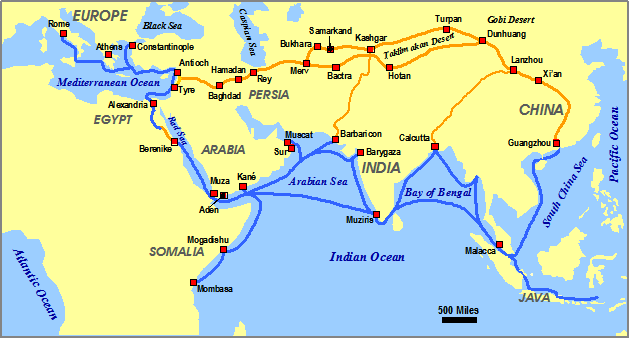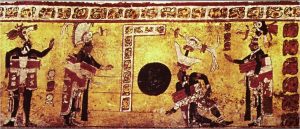If we go back to the second and third centuries C.E. and to the trade routes of the Silk Roads, we find the Chinese Han Dynasty and the Roman Empire suffering large-scale outbreaks of epidemic disease.1 The most destructive of these diseases were probably smallpox and measles, and epidemics of bubonic plague may also have erupted.2 Although these diseases are the most well-known, there were many others. We have long suspected that disease traveled via the Silk Roads; and now we have the proof. Piers Mitchell, a paleopathologist at the University of Cambridge states, “This is the earliest evidence for the spread of infectious diseases along the Silk Road, and the first to find evidence at an archaeological site along the Silk Road itself.”3 Without the technology and medicinal techniques we practice today, the fatalities that these populations suffered were devastating.

The silk roads were an extensive series of trade routes that linked much of Eurasia and north Africa.4 The Xuanquanzhi relay station was a well known area along the Silk Roads that housed travelers and relayed messages. It was located in the town of Dunhuang, a key stopping point on the Silk Road within the Hexi Corridor.5 Not only were necessities exchanged here, but so were religions, cultures, and the many diseases. Through a study in China conducted by Doctors Hui-Yuan Yeh, Ruillin Mao, Hui Wang, Wuyun Qi, and Piers D. Mitchell, they were able to prove that Chinese liver fluke, roundworm, whipworm, and tapeworm were spread along the Silk Roads.6
The study took place in Gansu Province, located in north-west China, which contains the Hexi Corridor.7 This corridor formed a section of the Silk Road, an ancient network of thoroughfares extending 4000 miles.8

Hygiene sticks were excavated from the latrines at the Xuanquanzhi site in 1992. These sticks were made of wood or bamboo wrapped with cloth, to be used as personal hygiene sticks for wiping.9 Out of the many sticks that were collected, seven of them had remnants of fecal matter still attached. The samples were then mixed with distilled water and trisodium phosphate in order for the parasites to be isolated. The most significant finding was the Chinese liver fluke, as it could not have been endemic at Dunhuang, as the parasite requires a wet marshy environment for its life cycle.10 Due to the discovery of this specific parasite, it proves the argument that the Silk Roads were partly to blame for the mass distribution of diverse diseases. Although there are various ways for diseases to be distributed all over the world, travelers along the Silk Roads provided an easy way for some of the most deadly diseases to travel great distances to devastate two of the largest empires of the ancient world: the Chinese Han Dynasty and the Roman Empire.
- Jerry H. Bentley, Herbert F. Ziegler, and Heather E. Streets-Salter, Traditions & Encounters: A Brief Global History: Volume 1: To 1500, Fourth Edition, vol. 1 (New York, New York: McGraw-Hill Education, 2014), 166. ↵
- Bentley, Ziegler, and Streets-Salter, Traditions & Encounters: A Brief Global History, 166. ↵
- Charles Q. Choi, “Silk Road Gave Infectious Disease a Route, Ancient Poop Shows,” Live Science, July 21, 2016, accessed October 25, 2016, http://www.livescience.com/55505-silk-road-human-feces-infectious-disease.html. ↵
- Bentley, Ziegler, and Streets-Salter, Traditions & Encounters: A Brief Global History, 161. ↵
- Hui-Yuan Yeh et al., “Early Evidence for Travel with Infectious Diseases along the Silk Road: Intestinal Parasites from 2000 Year-Old Personal Hygiene Sticks in a Latrine at Xuanquanzhi Relay Station in China,” Journal of Archaeological Science: Reports 9 (October 2016): 759. ↵
- Hui-Yuan Yeh et al., “Early Evidence for Travel with Infectious Diseases along the Silk Road: Intestinal Parasites from 2000 Year-Old Personal Hygiene Sticks in a Latrine at Xuanquanzhi Relay Station in China,” Journal of Archaeological Science: Reports 9 (October 2016): 758. ↵
- Hui-Yuan Yeh et al., “Early Evidence for Travel with Infectious Diseases along the Silk Road: Intestinal Parasites from 2000 Year-Old Personal Hygiene Sticks in a Latrine at Xuanquanzhi Relay Station in China,” Journal of Archaeological Science: Reports 9 (October 2016): 759. ↵
- Hui-Yuan Yeh et al., “Early Evidence for Travel with Infectious Diseases along the Silk Road: Intestinal Parasites from 2000 Year-Old Personal Hygiene Sticks in a Latrine at Xuanquanzhi Relay Station in China,” Journal of Archaeological Science: Reports 9 (October 2016): 759. ↵
- Hui-Yuan Yeh et al., “Early Evidence for Travel with Infectious Diseases along the Silk Road: Intestinal Parasites from 2000 Year-Old Personal Hygiene Sticks in a Latrine at Xuanquanzhi Relay Station in China,” Journal of Archaeological Science: Reports 9 (October 2016): 759. ↵
- Hui-Yuan Yeh et al., “Early Evidence for Travel with Infectious Diseases along the Silk Road: Intestinal Parasites from 2000 Year-Old Personal Hygiene Sticks in a Latrine at Xuanquanzhi Relay Station in China,” Journal of Archaeological Science: Reports 9 (October 2016): 761. ↵



34 comments
Elizabeth Guardiola
I had not heard much about The Silk Road but this article was very insightful! It is interesting to think that after all this time, we were able to discover the cause of the disease outbreaks and epidemics that occurred so long ago. It also further demonstrates the importance of medical and technological advancements for today’s day and age, without it, we would still have those fatal disease outbreaks!
Abigale Carney
Very interesting article! The Silk Road was a lifeline for trade among people, which gives me an uneasy feeling that the exchanges carried life necessities as well as diseases. After reading Alexander’s comment, I agree it is shocking that most people believed these illnesses were brought by bad spirits rather than poor hygiene. It is unfortunate that so many people were affected by these diseases, but at least it encouraged people to start practicing better hygiene and led to productive growth within the field of health.
Alexander Manibusan
The Silk Roads were not only prosperous trade routes, but they were also the paths for how disease can spread with ease. As many know, diseases can spread rapidly, especially when there is a concentrated population. However, it saddens me how back then many thought diseases were caused by bad spirits or bad air, rather than poor hygiene. Great article.
Bictor Martinez
With all the exchanging of goods, spices, clothing, etc. between the Silk Road, people did not know what else they were exchanging. It is kinda of crazy to think that these people that were exchanging goods carried diseases that can wipe out possible a whole empire. Thanks to our advanced technology we have today, we were able to see where the deadly diseases originate from. Great article.
Eric Ortega Rodriguez
In high school, I remember hearing about the Silk Road, but I had never heard of the many diseases that were transferred from place to place because of it. I find it astonishing how much impact it had on the Chinese Han Dynasty and the Roman Empire. I find it bizarre how they used sticks for personal hygiene and was surprised to see all the information was able to be drawn out of sticks. Overall, this article was informative since it explores the side of the Silk Road that not many people know about.
Madison Downing
Who would have thought that so many varieties of diseases plagued powerful empires because of their own citizens and allies. I still can’t believe that because of a wonderful concept like trade would be the killer that took so many lives back in the day. Of course now-a-days people know how to handle diseases but they can grow and change or new ones can be created. This is a dangerous world we live in and we will always need to be careful.
Jabnel Ibarra
Its always interesting reading about how people dealt with diseases throughout history. Because disease is quite literally an invisible killer, one can only imagine what deaths would have been attributed to in a time when there was no knowledge of viruses, bacteria, and infection. We are lucky to have the knowledge to be able to look back and know what it was that took so many lives.
Roman Olivera
This is a brief but informative article about a subject I never heard about. It’s crazy to think we study the diseases from so long ago from samples fecal matter from that time. This is a great find in relation to the spread of disease and showing reasons for loss of so many people during that time period. Many times throughout history the mixing of different populations brought great disease epidemics in those communities and population during growth. Sad to see that the advances in trade brought with it such destruction of life.
Noah Bolhuis
Disease has been known to spread west into Europe from Asia and Euasia, but I hadn’t known the silk road was such a big factor in that spread.. I seems obvious, as there were people that had never been exposed to certain diseases going along a heavily populated road with strangers. However, the thing that I found most interesting about this article is that these people, nearly 2000 years ago, used sticks as toilet paper, and called them “hygiene sticks.”
Rebecca Campos
I never thought about disease so much whenever the topic of the Silk Roads came up. I only ever really thought about trade and the profit that came along with it. The most striking detail would have had to be regarding the hygiene stick. The hygiene stick ironically sounds like the most unsanitary thing I’ve ever heard of. The article was very informative about the hard truth of the Silk Roads and some of the struggles that came with the trading lifestyle.